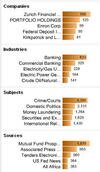Factiva Search 2.0: Compelling for the Advanced Researcher
A few weeks ago, Factiva launched the beta of its Search 2.0 interface. Search 2.0 is built upon the FAST Search & Transfer search engine and leverages Factiva’s taxonomies. Based upon my initial testing, Search 2.0 is an elegant and compelling solution for librarians and advanced researchers.
The basic interface of Search 2.0 presents results in a format familiar to novice and professional searchers.
 At the top of the page are three tabs, separating your results by content type – Publications, Web News and Pictures. The bulk of the screen consists of your results, ordered by relevance, and including a keyword-in-context (KWIC) summary of each document.
At the top of the page are three tabs, separating your results by content type – Publications, Web News and Pictures. The bulk of the screen consists of your results, ordered by relevance, and including a keyword-in-context (KWIC) summary of each document.
Along the right column of the user’s screen is a new set of visualization and clustering features all under the heading of “Discovery Pane”.
At the top of the Discovery Pane is an interactive distribution chart of the number of documents that meet your search criteria, by week.
Below the distribution chart is a section entitled "News Clusters", which provides a cloud view of noun- and verb-phrases which show up most frequently in the result set.
 Users of deli.cio.us will recognize the cloud format which makes it easy to navigate the terms which ar dominant within the results.
Users of deli.cio.us will recognize the cloud format which makes it easy to navigate the terms which ar dominant within the results.
Below that are four distribution charts, each clustering the results based upon Companies, Industries, Subjects and Sources. Each bar of the distribution chart shows the number of documents that match, similar to how Endeca search results are presented. Results are updated dynamically as you click through various parameters.
Results of a search can be saved as an Alert by simply clicking an “Alert Me” button. Users can then specify the email address, format and frequency for alerts to be sent.
Summary:
Overall, Factiva Search 2.0 is a compelling interface for the researcher. When compared to the search engines of traditional aggregators, Search 2.0 is a breath of fresh air. Factiva’s behind-the-scenes tagging enables users to have a common interface for all of the Factiva content, so there’s no need to look up arcane search criteria (as compared to three binders of database-specific search guidance provided by Dialog). How many users will use the advanced features only time will tell. While navigating the Discovery Pane can dramatically improve relevancy, search engine studies consistently show that the average user types fewer than two words into a typical keyword search. Of course, Factiva’s user base is focused on knowledge workers and librarians, so their behavior may be different than the typical Google user.
I’d propose a few modest enhancements to the Discovery Pane. Largely for real estate purposes, each cluster includes the results of the top five matching results. In many cases, however, when I’m looking for that “needle in a haystack” document, it’s not the categories at the top that are most interesting, but rather those at the bottom. For example, to learn about the money laundering software industry, I typed in “money laundering” as my search term. The top five industries listed were banking, commercial banking, electricity/gas, electric power generation and crude oil. I am sure that computer software appears somewhere on that list, but there’s no way for me to drill down to find out. The ability to bring up all the matching industry categories would be a great enhancement. Similarly, the news cluster cloud today remains more intriguing than useful. In a large content collection (my “money laundering” search yielded more than 13,000 results), there are many phrases that might be of interest. The news cluster cloud only showed me the first five results which were hardly meaningful. The alerting features are clean and easy to use, and the daily or twice daily frequency lets me set up multiple alerts without it resulting in “alert overload”.Factiva continues to be a forward-thinking organization and Search 2.0 shows it. Unlike their competitors who are held back by massive legacy systems, Factiva has the ability to integrate COTS software like FAST into its solutions. The visualization tools, while somewhat rudimentary, are an important step in providing its users with multiple ways to navigate its content. Search 2.0 is off to a good start and will surely continue to improve in the months to come.








Comments